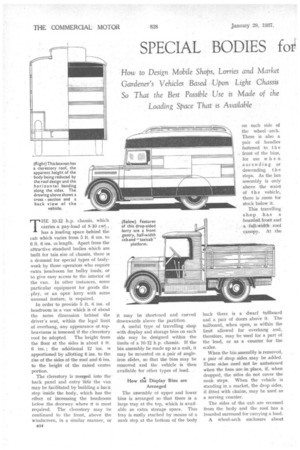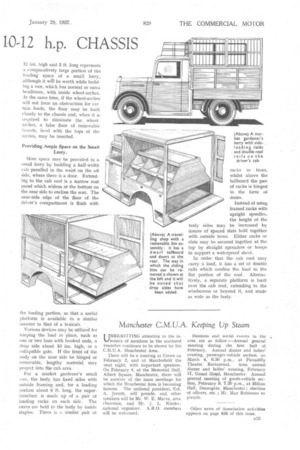SPECIAL BODIES for 10-12 h.p. CHASSIS
Page 48

Page 49

If you've noticed an error in this article please click here to report it so we can fix it.
THE 10-12 h.p. chassis, which carries -a pay-load of 8-10 cwt,.., has a loading space behind the cab which varies from 5 ft. 6 ins. to 6 ft. 6 ins, in length. Apart from the attractive standard bodies •which are built for this size of chassis, there is a demand for special types of bodywork by those operators who require extra headroom for bulky loads, or to give easy access to the interior of the van. In other instances, some particular equipment for goods display, or an open lorry with some unusual feature, is required.
In order to provide 5 ft. 6 ins, of headroom in a van which is of about the same dimension behind the
driver's seat, within the legal limit of overhang, any appearance of topheaviness is lessened if the clerestory soot be adopted. The height -from the floor at the sides is about 4 ft. 6 ins. ; the additional 12 ins, is apportioned by allotting 6 ins, to the rise of the sides of the roof and 6 ins.
to the height of the raised centre portion.
The clerestory is merged into the back panel and entry into the van may be facilitated by building a back step inside the body, which has the effect of increasing the headroom below the doorway where -it is most required. The clerestory may be continued to the front, above the windscreen, in a similar manner, or it may be shortened and curved downwards above the partition.
A useful type of travelling shop with display and storage bins on each side may be designed within the limits of a 10-12 h.p. chassis. If the bin assembly be made up as.a unit, it may be mounted on a pair of angleiron slides, so that the bins may he removed and the vehicle is then available for other types of load.
*
How the Display Bins are Arranged
The assembly of upper and lower bins is arranged so that there is a large tray at the top, which is available as extra storage space. This tray is easily reached by means of a sunk step at the bottom of the body
on each side of the wheel arch. There is also a pair of handles fastened to the front of the bins, for use when ascending or descending t h e steps. As the bin assembly is only above the waist of the vehicle, there is room for stock below it.
This travelling shop has a boarded_ front and a full-width roof canopy. At the back there is a dwarf tailboard and a pair of doors above it. The tailboard, when open, is within the limit allowed for overhang and, therefore, may be used for a part of the load, or as a counter for the scales.
When the bin assembly is removed, a pair of drop sides may be added. These sides need not be unfastened when the bins are in place, if, when dropped, the sides do not cover the sunk steps. When the vehicle is standing in a market, the drop sides, if fitted with chains, may be used as a serving counter.
The sides of the cab are recessed from the body and the roof has a boarded surround for carrying a load.
A wheel-arch enclosure about 12 ins, high and 3 ft. long represents a comparatively large portion of the loading space of a small lorry, although it witl be worth while building a van, which has normal or extra headroom, with inside wheel-arches. At the same time, if the wheel-arches will not form an obstruction for certain loads, the floor may be built closely to the chassis and, when it is required to eliminate the, wheelarches, a false floor of removable hoards, level with the tops of the arches, may be inserted.
Providing Ample Space on the Small Lorry.
More space may be provided in a small lorry by building a half-width cab panelled to the waist on the off side, where there is a door. Extending to the cab roof is a narrow seat panel which widens at the bottom on the near side to enclose the seat. The near-side edge of the floor of the driver's compartment is flush with the loading portion, so that a useful platform is available in a similar manner to that of a taxicab.
Various devices may be utilized for keeping the load in place, such as one or two bars with hooked ends, a drop side about 19 ins, high, or a collapsible gate. If the front of the oody on the near side be hinged or removable, lengthy material may project into the cab area.
For a market gardener's small van, the body has fixed sides with outside framing and, for a loading portion about 6 ft. long, the superstructure is made up of a pair of loading racks on each side. The eaves are held to the body by inside staples. There is a similar pair of
racks in front, whilst above the tailboard the pair of racks is hinged in the form ot doors.
Instead of using framed racks with upright spindles, the height of the body sides may be increased by means of Spaced •slats held together with outside irons_ Either racks or slats may be secured together at the top by straight spreaders or hoops to support a waterproof sheet.
In order that the cab root may carry a load, it has a set ot double rails which confine the load to the fiat portion of the roof. Alternatively, a separate platform is built over the cab roof, extending to the windscreen or beyond it, and made as wide as the body.




















































































